Research Reports / Rapports de recherche
Evidence From a Disaster:
The Ocean Ranger Collection at the Canada Science and Technology Museum
Prologue
1 In 1985, Mr David Grenville, secretary of the Royal Commission that investigated the loss of the Ocean Ranger drilling rig, arranged to donate the objects collected as part of the investigation to the Canada Science and Technology Museum. He had two reasons for taking this action. Litigation relating to the disaster was still in progress, as victims’ families attempted to win some compensation from ODECO, the owners of the rig. Parts of the collection might be needed as evidence and its integrity had to be protected. The Museum had the expertise to do this. A second and, I believe, secondary reason, for giving us the collection was its "historic and technological significance."1 In correspondence with the Museum’s director, Grenville stated "that some thought should be given to putting together an exhibit," before the collection, in his words, "is archived and forgotten."2
2 But the Museum has never exhibited the collection3 and, having read the compelling story of this disaster, I wondered why. When I began to look at the contents and character of the collection and talk to my colleagues about it, though, it be soon became clear that it not only posed significant museological challenges but also raised some fundamental questions about how we present modern technology in exhibits. The purpose of this paper is to discuss some of the issues raised by the Ocean Ranger collection.
The Disaster
3 In the early hours of 15 February 1982, the Ocean Ranger drilling rig capsized and sank off the Grand Banks of Newfoundland. All eighty-four of its crew died in the icy waters of the North Atlantic. The loss was an enormous blow to the people of Newfoundland and Labrador; fifty-six of the eighty-four crew members were from this small and "tightly-knit maritime community"4 and many residents could claim some connection to at least one of those lost. The disaster also dealt a severe blow to the optimism that had accompanied the discovery of the Hibernia oil field. The promise of jobs and a new source of revenue for a province plagued by chronically high unemployment and the decline of traditional industries like the fishery was real, but it came at a cost.
4 The offshore oil and gas industry felt the shock waves too. The Ocean Ranger was the largest self-propelled semisubmersible offshore drilling rig in the world at the time of her launch in 1976 and many in the industry considered this state-of-the-art unit "unsinkable."5 She had a history of drilling safely in weather conditions that forced other rigs to disconnect. Yet on the morning of 15 February, the two other rigs on the Hibernia field were secure and largely intact while the Ocean Ranger had somehow capsized. Coming less than two years after the rig Alexander Kielland had capsized in the North Sea taking 123 lives, this latest casualty focused international attention on the offshore drilling industry, its technology and its methods of operation.
5 In the days following the tragedy, as the bodies of twenty-two victims, wrecked lifeboats and other debris were pulled from the North Atlantic, Canadians and government and industry officials struggled to come to terms with the disaster. As with all maritime casualties, the loss of the Ocean Ranger immediately set in motion a series of inquiries, by the U.S. Coast Guard (USCG) and the National Trans portation Safety Board in the United States, where the rig was registered,6 and by the Canadian government. The latter marine casualty investigation became part of a much broader Royal Commission of Inquiry reporting to both the federal government and the government of Newfoundland and Labrador.
6 Of all the inquiries, the Royal Commission was the most comprehensive. It had a sweeping mandate: to determine not only why the rig sank, but also why none of the crew were saved and to explore how similar accidents could be avoided. Its investigation was to "go beyond the realm of acceptable conjecture or reasonable deduction based on circumstantial evidence." It would use "scientific investigation to determine why in fact the Ocean Ranger, alone of three rigs on Hibernia, capsized and sank."7
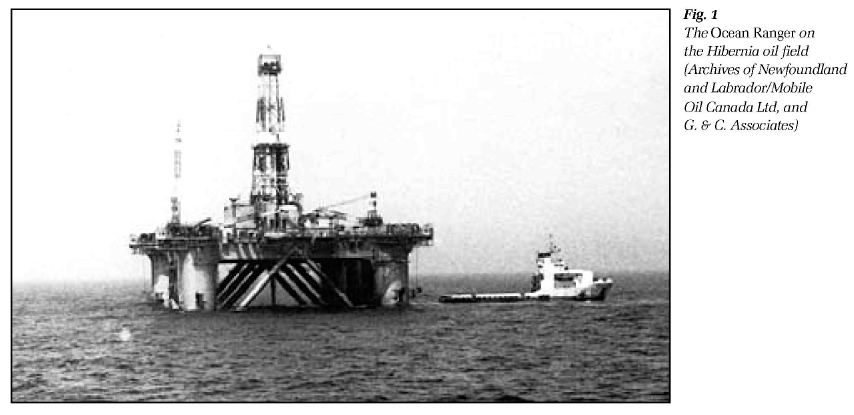 Display large image of Figure 1
Display large image of Figure 17 So what happened to the Ocean Ranger on that tragic night? During a severe storm, a wave broke the glass window of a porthole in the ballast control room. Water soaked the ballast control console and it began to malfunction. The crew tried to assess the damage and made a number of attempts to repair the panel, but they were hampered by a lack of training, information and informed direction. Their counter-measures were not only unsuccessful but actually made the situation worse. By around 0100, it was so serious — the bow was dipping down into the water at an angle of twelve to fifteen degrees — that the senior officer issued a Mayday and ordered evacuation.8 The evacuation, rescue and recovery attempts were also hampered by errors of judgement, design inadequacies and lack of proper training and equipment.9 The lifeboats and rafts were either inaccessible due to the angle of the rig or of no use in severe weather. The standby ships and helicopters were not designed for rescue and recovery; rather, they were equipped and crewed as supply and transport vehicles. The Ocean Ranger carried no survival suits.10 Autopsies on the recovered victims revealed what everyone who knew the North Atlantic suspected: death by drowning while in a hypothermic condition.11
8 The Royal Commission concluded that the loss of the Ocean Ranger was not the result of one catastrophic failure of design or construction, or even an obvious human error. The design deficiencies, though numerous, could have been overcome by "competent and informed action by those on board." But because of "inadequate training and lack of manuals and technical information, the crew failed to interrupt the fatal chain of events." If, after the porthole had broken, the crew had "only closed the deadlights, shut off the electrical and air supplies to the panel, cleaned up the water and glass and then retired for the evening, the Ocean Ranger and its crew would have survived the storm that night."12
The Ocean Ranger Collection
9 The collection of artifacts and archival materials donated to the Canada Science and Technology Museum is essentially a forensic one, made up of a large number of small articles and test samples. The material was either retrieved from the water in the days following the casualty or recovered from the rig during a series of dives ordered by the Royal Commission. Evidence retrieved as floating debris included a number of life preservers, an Emergency Position Indicator Radio Beacon (EPIRB), equipment from the rig’s lifeboats and rafts — parts of survival kits, oars, a radio transceiver. The recovery teams also collected what was left of the lifeboats and inflatable life rafts.
10 The artifacts recovered from the submerged rig were critical in explaining the loss. The commission sent its divers to the ballast control room where they recovered three portholes, critical components of the ballast control system including parts of the control console, sixty-four solenoid valves, a large number of indicator lights and microswitches, and, finally, hundreds of pages of documents relating to the daily operation of the ballast control system and the rig generally.13 The Aviation Safety Bureau of Transport Canada tested these items and produced nine engineering reports on their findings.
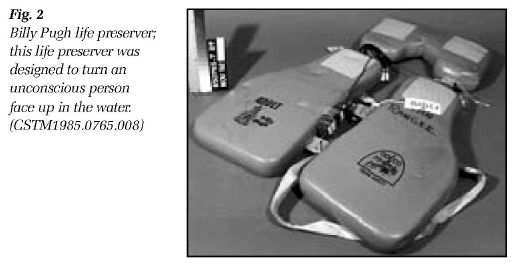 Display large image of Figure 2
Display large image of Figure 211 By studying the portholes, researchers determined which of the portholes had been broken during the storm. Air pressure tests showed that the porthole glass did not meet either the industry standard for strength or the thickness shown on the rig’s "as-built" plans. It also demonstrated that neither of these standards were sufficient to withstand wave forces that might occur in extreme storm conditions. They were developed for ships rather than drilling rigs anchored to the ocean floor.
12 Careful examination of the condition and disposition of the solenoid valves demonstrated that the valves functioned normally and that brass rods had been used to manipulate eighteen valves manually; where the rods had been inserted, the valves were open, although it was clear that the operators had thought they were closing the valves with the rods. The researchers also carried out analyses of the recovered ballast valve control switches and valve position indicator and pump switch lights on the control panel. These studies determined that sea water entering the ballast control panel had caused significant damage, where that damage occurred and how it affected what the operators saw as they tried to solve the ballast problem.14
The Exhibit Challenge
13 The story of the Ocean Ranger is a compelling one on a number of levels. Like all disasters involving the failure (or perceived failure) of technology, it forces us to confront our ambivalent feelings about technology and its central place in our lives. Museums of science and technology are naturally drawn to these types of stories because we believe it is our role to try to explain technological failures to the public, to help them come to terms with the confusion, anxiety and fear that often follow in the wake of these catastrophic events.
14 Disaster stories, though, also give rise to a forest of difficult and disorienting ethical and museological issues that can cause museums to lose their sense of direction and purpose. The public seems to have an appetite for technological tragedies, old and new, and it is natural for museums to take advantage of this. Ideally, they can use the popularity of these stories to attract visitors and, hopefully, to help them see beyond the disaster to some of the larger scientific, technological and social issues that explain and provide context for it.
15 However, ethical problems can arise when museums are too preoccupied with popularity and attendance. Like everyone else in the public and cultural sectors, they are under enormous pressure to generate more of their own revenue and, for many institutions, getting people through the door is the primary source of that revenue. It can also, for publicly-funded museums, serve as a justification for future funding. It is easy to be seduced by the argument that a really popular exhibit will help to fund less popular, but important work and attract new audiences, but experience shows that this strategy can have some enduring and detrimental effects on museums that adopt it.
16 Let’s take perhaps the most famous of all technological disaster stories as an example. The Titanic continues to fascinate millions of people and for any institution with Titanic-related artifacts, the temptation to use them is overwhelming. The story is so widely known and the articles associated with it have such mystical power in and of themselves that museums needn’t spend much time or effort on interpretation. The Canada Science and Technology Museum, for example, owns an excellent sixteen-foot model of Titanic that is a display unto itself, and it is one of the few artifacts that is never taken off the Museum floor.
17 Giving in to the Titanic temptation, though, has caused some serious problems for museums in the last decade. One of the world’s preeminent maritime museums, the National Maritime Museum at Greenwich, became the subject of controversy in 1996 when it decided to exhibit artifacts removed from Titanic by a company called RMS Titanic. These objects were retrieved in contravention of the 1993 by-laws passed by the International Congress of Maritime Museums (ICMM). The signatories of those by-laws sought to protect submerged wrecks as archaeological sites by refusing to "acquire or exhibit artifacts which have been…illegally salvaged, or removed from commercially exploited archaeological or historic sites." The National Maritime Museum was not only one of the founding and leading members of the ICMM, it had helped to draft and had signed these by-laws. Only three years after doing so, however, the director of the museum found the potential to create a popular (and profitable) exhibit too appealing to resist and decided to ignore the by-laws.15
18 At the Maritime Museum of the Atlantic in Halifax, a more subtle problem arose. This museum has its own collection of Titanic artifacts and mounted an exhibit built around these in the late 1990s. It was not entirely clear why the museum, which has a rich collection and great expertise in subject areas more closely related to Canada’s Atlantic history, chose to devote resources to an exhibit on this topic. Many in the local and maritime museum communities, though, worried that the decision had too much to do with popularity and not enough to do with mandate and sound museological practice. The eventual inclusion of the inflatable Titanic slide as an added, temporary attraction could only have reinforced these concerns. The exhibit was an unparalleled commercial success, so much so that it has apparently created unrealistically high expectations in the director’s office. Will all exhibits now be judged according to the attendance and revenue figures established by Titanic? Will only those exhibits that promise similar popularity make it past the proposal stage?
19 Despite certain obvious similarities, such as the location of the casualty and the careless use of the adjective "unsinkable," the Ocean Ranger is, clearly, not in the same league as Titanic. Without the enormous popularity and mystique of the topic, we are not subject to the same level of temptation when considering an exhibit. Nevertheless, some of the same concerns apply. Even if people don’t remember the Ocean Ranger tragedy, I have no doubt that, once reminded of it, many will want to look at items such as the life preservers, survival kits and lifeboat fragments just because they were there on that tragic night. They might even find some numinous power in the more technical artifacts, some of which still bear legible markings indicating their origin.
20 We could use the pieces of survival gear to tell our visitors the poignant story of how the standby vessel Seaforth Highlander came so close to recovering a lifeboat filled with men, of how the ship’s crew watched helplessly as the boat capsized and how some of the men struggled to survive by clinging to the overturned boat in the icy waters. We could even make this display part of a thematic exhibit that purported to explain life-saving technology and technique to give it greater museological legitimacy, assuming we have the collection to support it. Or we could use the survival equipment as a hook to draw people into an exhibit that explained the research behind the investigation, including that relating to emergency equipment and procedures.
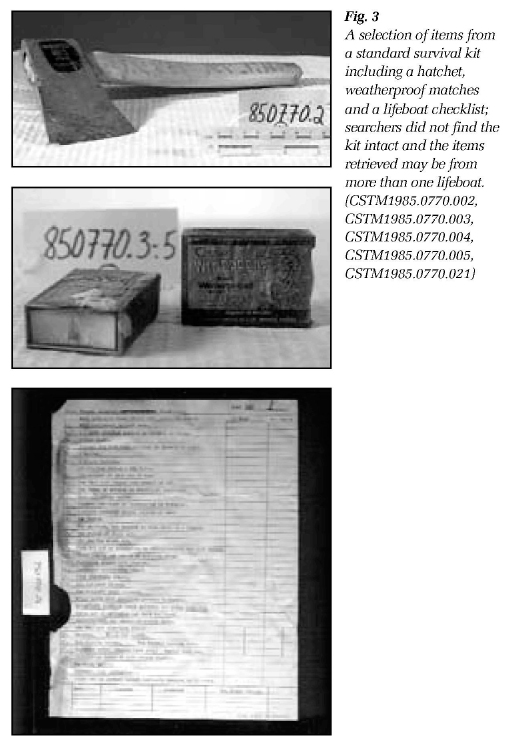 Display large image of Figure 3
Display large image of Figure 321 One way museums can avoid the pitfalls inherent in disaster stories is to stay focused on their social responsibility. As I noted earlier, technological disasters, especially recent ones, are a very real source of public anxiety. In their aftermath, people have a legitimate need for explanations. Many of these come out in the investigations that follow these accidents. Canada’s Transportation Safety Board, for example, just released its final report on the loss of Swiss Air Flight 111, which crashed in Canadian waters in September 1998. It contains some fairly definitive answers to questions about what caused the fire onboard the aircraft and why the pilot did not attempt an immediate emergency landing. Both of these questions had been a source of public concern and speculation.
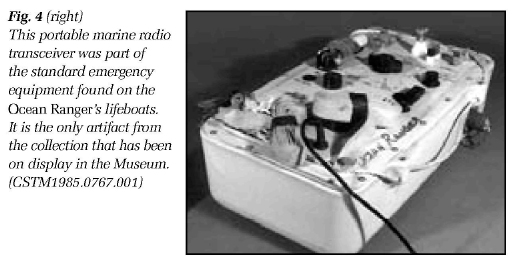 Display large image of Figure 4
Display large image of Figure 4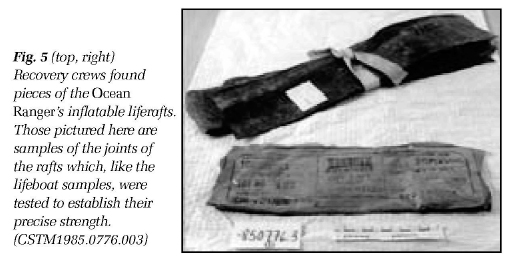 Display large image of Figure 5
Display large image of Figure 5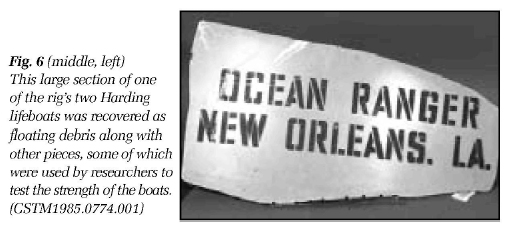 Display large image of Figure 6
Display large image of Figure 6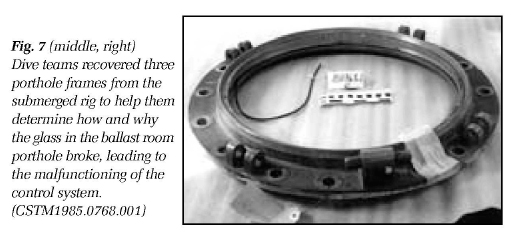 Display large image of Figure 7
Display large image of Figure 7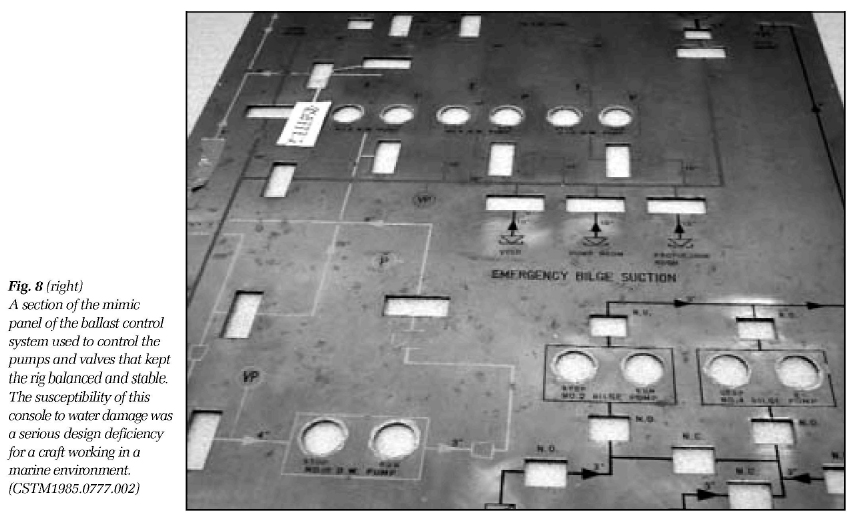 Display large image of Figure 8
Display large image of Figure 822 Museums of science and technology, many of which were created with strong educational mandates, can also contribute to this process of explanation. In some instances, we are ideally equipped to act as intermediaries between the researchers and the public, to provide a simplified interpretation of complex scientific work and to put it into a broader chronological and thematic context. But we need to be very clear about what we are doing and why. Before thinking about creating an exhibit on the Ocean Ranger investigation or any other difficult topic, we have to ask ourselves some searching questions about the whole enterprise.
23 1) Is this an important story in the history of science and technology? This is, of course, a highly subjective question. I find it helps to frame the question in terms of three fundamental themes in the history of science and technology: the process and nature of technological change; how we understand science and how it effects our lives; and the cultural and social meaning of science and technology.16 Using these themes as selection criteria, I believe we would be inclined to steer away from stories like Titanic, unless they could be framed in such a way as to deal directly with subjects such the disaster’s impact on ship design. The Ocean Ranger story is one of many examples of a technological failure caused by a complex chain of minor events involving design, training and regulatory inadequacies as well as human error. Like the Challenger, ValuJet and Swiss Air disasters,17 it warrants our attention as both a cautionary tale about the limitations of technology and, hopefully, a record of important lessons learned about this particular technology.
24 2) If this story is important, is it one that has particular relevance and resonance for our institution and is it one that hasn’t been told effectively by other museums? Mandates are notoriously flexible these days, with museums struggling to attract new and larger audiences and to generate revenue by any means possible. If a subject is popular but lies outside or on the periphery of a museum’s mandate, should it be considered and if so, should the level of funding reflect the relevance of the topic? This was one of the issues raised by the Titanic exhibit in Halifax. Being clear about why you are doing an exhibit and how it fulfills your institution’s duties and responsibilities is particularly important when dealing with difficult or controversial subject matter.
25 The Canada Science and Technology Museum’s responsibilities include collecting, preserving and researching Canada’s scientific and technological heritage and sharing knowledge about that heritage. The Ocean Ranger story is relevant to the Museum’s mandate because it involves a technological failure that took place in Canadian waters and took the lives of sixty-nine Canadians. It is also relevant because much of the research work was carried out by Canadian scientists and engineers and because the results of the inquiry have had a profound effect on the offshore oil and gas industry in Canada and around the world. In this context, it seems to me that the most important of many stories the Museum could tell is the one focusing on the investigation. We ought to try to explain how researchers were able to piece together what happened on the rig that night.
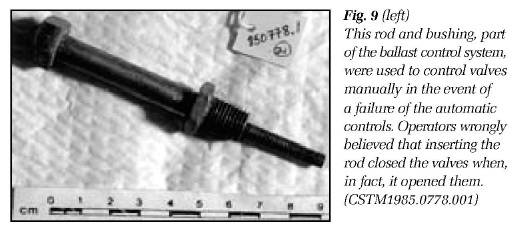 Display large image of Figure 9
Display large image of Figure 9 Display large image of Figure 10
Display large image of Figure 10 Display large image of Figure 11
Display large image of Figure 1126 3) Is there an existing collection relevant to the story and, if so, do the artifacts serve readily and well the preferred narrative line? Underlying this complex question are some contentious museological assumptions. We need artifacts to do an exhibit. Some museums and most science centres do exhibits without artifacts or with artifacts playing a very secondary role. But is this in the best interest of museums? In the intensely competitive cultural and recreational marketplace, museums are under increasing pressure to be "all things to all people," by, among other things, building IMAX theatres and renting out facilities for functions that often disrupt both work and public access to the institution. In this context, it is easy to lose sight of what it is we do best and what it is that distinguishes us from the many other purveyors of information, education and entertainment out there.
27 Museums collect artifacts and create exhibits by displaying them in a particular way and by providing them with physical and intellectual context. We offer people the opportunity to look at and interact with three dimensional objects. They can see that these things have a particular structure, texture, style and size. They can understand them in the context we provide but they can also bring their own experience and interpretations to bear, looking at the artifacts in new and sometimes unexpected ways. We do this based on the premise that artifacts are historical documents, that is, that they contain information that can’t be found anywhere else. This makes artifacts and the exhibits built around them both a unique record of our past and a unique form of communication with the public. We always use other media to complement the artifacts but what really sets us apart is the interpretation of artifacts.18
28 The second part of the question — do the artifacts serve readily and well the preferred narrative line — opens up another area of debate. Should artifacts be defined as I have defined them above, as essential, unwritten documents of our past that hold information that can’t be found in standard documentary sources? Or should they be more loosely understood and used as illustrations of our past, objects that complement and reinforce the stories we know from other, more traditional source material? Does it matter?
29 I think it matters a great deal. Museums are in the business of collecting, conserving, storing, researching and interpreting artifacts. They do this to document the past and to share that past with the public, and it costs a great deal of money to do it properly. If artifacts are only useful as three dimensional illustrations, isn’t it fair for someone to ask why can’t we do without them or, at least, with out many of them? Surely we can make do with other, less demanding and costly forms of illustration.
30 This is a particularly important question for museums of science and technology. Institutions like the Canada Science and Technology Museum are struggling to keep pace with technological change in dozens of fields. We are expected to collect, document and interpret modern technologies many, if not most, of which are incredibly complex and often expensive. Yet many of these devices and systems have the generic, uninformative appearance of much modern technology. So how do we justify spending time and money collecting these artifacts if the information they contain is buried inside them and largely inaccessible to researchers and visitors alike? Would it not be more worthwhile to document and interpret these advances by obtaining the relevant manuals, photographs and diagrams or perhaps by interviewing the inventors? And might it not make more sense to present "inscrutable" technologies to the public in the form of a photo essay, a computer interactive, a book or a television program?19
31 Now consider the Ocean Ranger artifacts. Clearly this collection is relevant to the story of technological failure but do the artifacts serve that story readily and well? And is it possible that other media might tell the story more effectively?
32 Some of the Ocean Ranger artifacts are familiar enough objects — the life preservers, survival kit and emergency radio, for example. Taken together, this group of artifacts does tell us, quite poignantly, that this was a marine disaster and that it involved a loss of life. No doubt for a select group — friends and family of victims, those who work on offshore rigs — some of these will have a numinous quality. That loss of life is, in part, what led to the comprehensive investigation of the casualty and of the off shore drilling industry. The one large piece of lifeboat that was recovered and which bears the name of the rig would also support this message though most visitors would not identify it on its own. So far so good.
33 Now on to the forensic artifacts — the solenoid valves, the brass rods, the indicator light bulbs and the switches. Most of these are not readily identifiable or understandable; they are, in effect, de-contextualized20 scientific specimens that represent, but don’t document or even illustrate, the research done by scientists and engineers to discover the cause of the accident. Though some of the objects bear marks that suggest their role as test specimens, these don’t contribute much to our understanding of what the researchers did to them and what crucial information they gained from the tests. In an exhibit, therefore, we would have to provide critical parts of the narrative — the process of scientific testing and reasoning — using media other than artifacts. Most of the objects would simply serve in a secondary, supporting role, as three-dimensional illustrations.
34 Would this be a bad exhibit? Not necessarily. The story would, I think, rely heavily on text, audio-visual and interactive displays but this Museum is quite accomplished at using these media to convey complex ideas and processes. We could also try to borrow one of the specially-built hydrodynamic models used by researchers to analyse the movements of the Ocean Ranger during the storm.21 These models are detailed and quite large and would help us to give visitors some kind of physical and spatial context for certain of the artifacts as well as a sense of overall rig design. We might even be able to show video of some of the testing that was done using these models. This would also make a dramatic addition to an exhibit otherwise dominated by small objects and fragments of objects.
35 It might be possible to communicate the message of design inadequacies by displaying a broken port hole in close proximity to the control console. A "mock-up" of the ballast control room showing the locations of the panels and their critical components could help people make more sense of the forensic artifacts recovered from this area. But this would still leave us with the challenge of how to represent the scientific testing and reasoning that ultimately explained the casualty. Then there are the failures of training and of regulation, both of which are central to understanding what happened that tragic night in February 1982.
36 Do I think we ought to try to create an exhibit using the Ocean Ranger collection? I think it would be an interesting and challenging exercise. And I think this sort of exercise would force any museum of science and technology to ask some hard questions about what and why they collect and how they make decisions about what to exhibit. These are difficult times for museums. As budgets decrease and competition for funds intensifies, we are increasingly expected to justify not only our major decisions and expenditures but sometimes our very existence. More than ever, we need to be able to provide a clear and compelling explanation of what it is we do and why it matters.